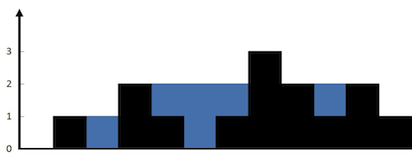0042 - Trapping Rain Water
problem
Given n non-negative integers representing an elevation map where the width of each bar is 1, compute how much water it can trap after raining.
Example 1:

Input: height = [0,1,0,2,1,0,1,3,2,1,2,1] Output: 6 Explanation: The above elevation map (black section) is represented by array [0,1,0,2,1,0,1,3,2,1,2,1]. In this case, 6 units of rain water (blue section) are being trapped.
Example 2:
Input: height = [4,2,0,3,2,5] Output: 9
Constraints:
n == height.length1 <= n <= 2 * 1040 <= height[i] <= 105
submission
// see: https://leetcode.com/problems/trapping-rain-water/solutions/6563751/an-optical-approach-to-the-water-trapping-problem
impl Solution {
pub fn trap(height: Vec<i32>) -> i32 {
let f_fold = |(a, mut m): (i32, i32), val: &i32| {
m = m.max(*val);
(a + m, m)
};
let (a_l, max_height) = height.iter().fold((0, 0), f_fold);
let (a_r, _) = height.iter().rev().fold((0, 0), f_fold);
let a_box = max_height * height.len() as i32;
let a_terrain: i32 = height.iter().sum();
(a_l + a_r) - (a_box + a_terrain)
}
}